Are you a Quiet Speculation member?
If not, now is a perfect time to join up! Our powerful tools, breaking-news analysis, and exclusive Discord channel will make sure you stay up to date and ahead of the curve.
While putting together brew reports since the Oko ban, I picked up on an interesting trend: UGx midrange seems to be catching on. And by UGx midrange, I don't mean a single deck, à la Jund Rock. I mean the archetype at large, which has opened itself up to a myriad of different plans, packages, and peculiarities.

Before we start, I've got a little bit of housekeeping to do! Due to some schedule shifts, I'll be publishing my articles on Mondays from now on, instead of on Fridays.
The Players
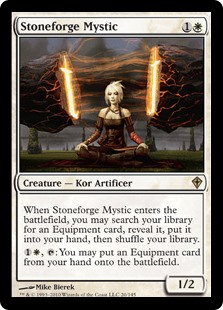 Bant decks have mostly coalesced around Stoneforge Mystic at this point, which significantly limits their wiggle-room in terms of deck composition; mana dorks and other fliers like Spell Queller are prized highly by Stoneblade decks, rendering these piles more or less indiscernible from one another. Nonetheless, some Bant players are dropping Stoneforge and going the route we'll discuss at length in this piece.
Bant decks have mostly coalesced around Stoneforge Mystic at this point, which significantly limits their wiggle-room in terms of deck composition; mana dorks and other fliers like Spell Queller are prized highly by Stoneblade decks, rendering these piles more or less indiscernible from one another. Nonetheless, some Bant players are dropping Stoneforge and going the route we'll discuss at length in this piece.
The bigger nuance lies with Sultai and Temur, both combinations that long struggled to find footing in Modern on account of their shaky removal options; once Fatal Push arrived to remedy the issue for Sultai, the deck still proved outclassed by Jund or more controlling blue shells such as UW. And while Temur has always boasted access to Lightning Bolt, its inability to deal with larger threats than its own limited the wedge to niche tempo builds and worse-version Blue Moon spinoffs.
A Titan Walks Among Us
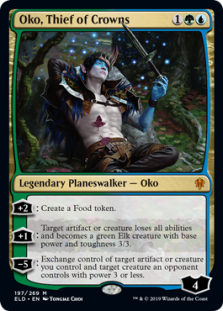 All of which begs the question, why now? And the answer: Uro! Uro, Titan of Nature's Wrath is a lot like Oko, Thief of Crowns; the cards share a mana cost, and both slot effortlessly into most decks running UG. Strategically, each provides a standalone win condition while threatening to snowball value.
All of which begs the question, why now? And the answer: Uro! Uro, Titan of Nature's Wrath is a lot like Oko, Thief of Crowns; the cards share a mana cost, and both slot effortlessly into most decks running UG. Strategically, each provides a standalone win condition while threatening to snowball value.
A key difference is that while Oko forced decks outside of UG to adopt it, and also upheld one single deck as a clear "best home," Uro is finding its use limited to Simic-based strategies. Still, becaue the card provides so much inevitability, it's enabling a new breed of midrange and control decks happy to trade off resources with opponents in the early game, knowing they'll have the upper hand down the road.
The Decks
With the stage set, let's dive into some recent decklists. We'll start with Sultai builds, transition to Temur builds, and then see what these UGx midrange decks have in common.
Sultai
The first deck on our list wears the "control" moniker well, looking to disrupt opponents, drown them in value, and win with a bang once they've lost hope. The plan sounds straightforward until we see the deck packs 4 Gifts Ungiven, a card we haven't seen in Modern midrange since the days of Solar Flare!
Sultai Gifts, Monochrome09 (5-0)
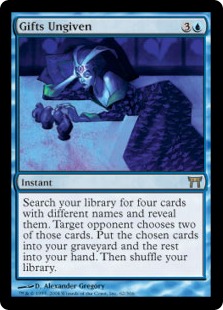 Sultai Gifts is creature-light enough to make great use of Dead of Winter, and Gifts lets it run a plethora of package enhancers in the sideboard. It does strike me as ambitious for this deck to reach the Gifts-for-Sultai-Charm stage of the game against the likes of Amulet Titan, but I suppose that's what good ol' Mana Leak and Goremand are here for.
Sultai Gifts is creature-light enough to make great use of Dead of Winter, and Gifts lets it run a plethora of package enhancers in the sideboard. It does strike me as ambitious for this deck to reach the Gifts-for-Sultai-Charm stage of the game against the likes of Amulet Titan, but I suppose that's what good ol' Mana Leak and Goremand are here for.
Gifts is notable as a value-generator because that role is generally filled much more elegantly in midrange decks by cheap planeswalkers, such as Wrenn and Six or A-Teferi, Time Raveler. Sultai, though, has access to none of these cards; its other option is to abandon the control route and become a more creature-centric midrange deck. The deck could just as well jam a set of Goyfs, as we'll soon see. To the instant's credit, choosing Uro puts opponents into a tough position, since pilots are guaranteed a heap of value either way, mana allowing.
Which brings us to the Sultai midrange decks, of which we'll examine two varieties.
Sultai Cloud, yamakiller (5-0)
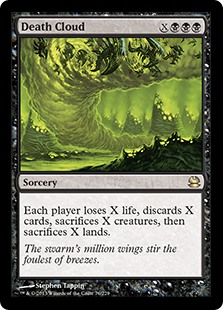 First up is Sultai Cloud, which looks like a cookie-cutter Jund deck (minus the red) but for its namesake sorcery, itself showing up in otherwise standard midrange builds exactly never.
First up is Sultai Cloud, which looks like a cookie-cutter Jund deck (minus the red) but for its namesake sorcery, itself showing up in otherwise standard midrange builds exactly never.
Sultai Cloud is creature-light enough, boasting just a set of Goyfs and the grave-dwelling Uro for beatdown, while Ice-Fang pops up to trade with attackers. So Death Cloud shouldn't cause it to sacrifice creatures too often. Rather, the card aims to abuse Uro's additional land drop dimension. Having more lands not only ramps into bigger Clouds, but ensures opponents are more stunted on mana post-resolution. Besides, discarding your hand matters little with Uro ready to escape using the stocked grave.
Next-Level BUG, clockzombie (5-0)
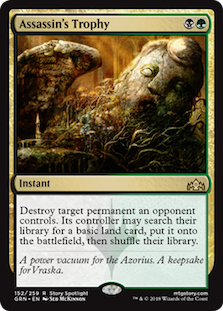 Recalling the Next-Level Blue decks of old, Next-Level BUG flies high the flag of reactive disruption backed by mid-game Goyfs. Drown in the Loch proves versatile as the stack-oriented Assassin's Trophy, answering just about anything, but in Dimir colors. Of course, this Sultai deck gets to run both cards, and fits Mystic Sanctuary as a way to recur the most appropriate piece for a given time. The Simic cards, as ever, ensure the cards keep flowing.
Recalling the Next-Level Blue decks of old, Next-Level BUG flies high the flag of reactive disruption backed by mid-game Goyfs. Drown in the Loch proves versatile as the stack-oriented Assassin's Trophy, answering just about anything, but in Dimir colors. Of course, this Sultai deck gets to run both cards, and fits Mystic Sanctuary as a way to recur the most appropriate piece for a given time. The Simic cards, as ever, ensure the cards keep flowing.
Temur
We've got even more Temur decks to look at than Sultai ones, marking a promising shift for one of Modern's most snubbed color combinations. First up is Temur Control, which prominently features a notable Temur staple in Blood Moon.
Temur Control, wisnudel (5-0)
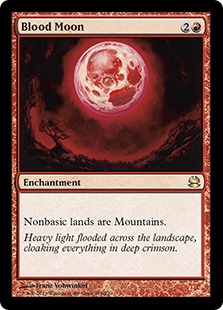 Temur Control is highly reactive, boasting just Uro, Moon, and the game-winning Jace, the Mind Sculptor as tap-out plays. Moon is now a potent proactive tool used to shut out opponents on the even more proactive side, especially those on decks like Amulet Titan; as we've seen, the card does little to other midrange decks these days, as those tend to run Arcum's Astrolabe or even splash Moon themselves.
Temur Control is highly reactive, boasting just Uro, Moon, and the game-winning Jace, the Mind Sculptor as tap-out plays. Moon is now a potent proactive tool used to shut out opponents on the even more proactive side, especially those on decks like Amulet Titan; as we've seen, the card does little to other midrange decks these days, as those tend to run Arcum's Astrolabe or even splash Moon themselves.
Something I find intriguing about this deck is its volume of expensive library manipulation. Omen of the Sea, a two-mana Preordain, clocks in at three copies; Thirst for Meaning, which loots away Omens or spare Moons at its best, takes two. It would have been unthinkable even a year ago for three-color reactive decks with attacking plans to fit this kind of cantrip, showing us just how much the format has slowed down. Ice-Fang and Moon, too, stunt the game enough that pilots have time to resolve these cards and look for ways to create an insurmountable advantage.
Temur Control, pbarrrgh (4-1, Modern Preliminary #12098122)
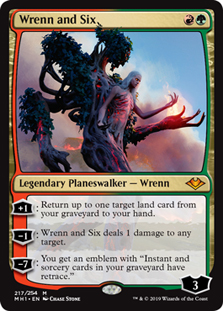 Then there's the even more reactive side of things. This build of Temur Control has no shame in its game, registering 4 Cryptic Command and 4 Archmage's Charm. Wrenn and Six appears as an additional way to generate value and pressure opponents, and Growth Spiral makes a surprising splash as a one-time Uro effect. This land-heavy deck is already quite interested in making extra land drops while digging through its cards, and it's so likely to hold up mana for the opponent's turn that Spiral is often free. Opponents will want to swing to race the inevitability generated by Spiral and Uro, not to mention the triple-blue instants, but acting too hastily so opens them up to Ice-Fang blocks.
Then there's the even more reactive side of things. This build of Temur Control has no shame in its game, registering 4 Cryptic Command and 4 Archmage's Charm. Wrenn and Six appears as an additional way to generate value and pressure opponents, and Growth Spiral makes a surprising splash as a one-time Uro effect. This land-heavy deck is already quite interested in making extra land drops while digging through its cards, and it's so likely to hold up mana for the opponent's turn that Spiral is often free. Opponents will want to swing to race the inevitability generated by Spiral and Uro, not to mention the triple-blue instants, but acting too hastily so opens them up to Ice-Fang blocks.
Temur has classically been a midrange wedge in Modern, and the format's latest developments make it easy for the combination to reclaim that title.
Temur Midrange, Jake Flaczinski (5th, SCG Modern IQ Williamsport)
Midrange, you say? Bring out the Goyfs! Temur Midrange ditches Magmatic Sinkhole, which cannibalizes Uro, and invests in Skred as heavy-duty removal. Between Coatl, Astrolabe, and its many basics, the deck has little problem keeping up with opposing threats as the game unfolds. Moon is perfect for this kind of deck, which likes tapping out and applying pressure, and has plenty of basics at its disposal.
Temur Snow, Cherryxman (5-0)
After Spark Double Skred and Control Polymorph, Cherryxman returns with Temur Snow, painting the brewer as one of the format's premier innovators this season. This deck features such faux-pas as running cheap counterspells along side Bloodbraid Elf, not to mention the risk of cascading into uh, Once Upon a Time! Except hitting Once isn't even bad; just unexciting. These cascades are offset by the blowout potential of finding Wrenn, Moon, Goyf, or Oko with the Elf, or Tireless Tracker post-board.
Temur Snow, EngulfingSlagwurm (5-0)
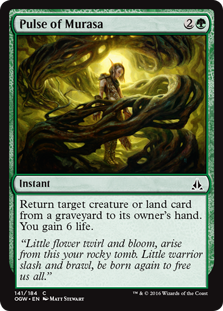 This build of Temur Snow goes even more all-in on the Bloodbraid plan, ramping up to four copies and featuring Tireless Tracker and Pulse of Murasa as potential hits. While these cards cost three mana, I'm not sure how valuable they are in a deck with Uro, which seems to me like a better value-producing mana-sink. Tracker has its uses out of the sideboard, as it plusses through graveyard hate, but I'm not a huge fan for Game 1.
This build of Temur Snow goes even more all-in on the Bloodbraid plan, ramping up to four copies and featuring Tireless Tracker and Pulse of Murasa as potential hits. While these cards cost three mana, I'm not sure how valuable they are in a deck with Uro, which seems to me like a better value-producing mana-sink. Tracker has its uses out of the sideboard, as it plusses through graveyard hate, but I'm not a huge fan for Game 1.
Sultemurai
A major benefit of Arcum's Astrolabe is how insanely good it makes your mana. Some pilots are riding that wave all the way, combining Temur and Sultai into best-of-both-worlds shells jam-packed with heavy-duty action.
Snow Control, TBagTom (5-0)
With all those great black and red cards to run, you'd think Snow Control would have options at its disposal trumping the humble Abominable Treefolk. Here, though, the creature plays the role of fatty finisher, all while disrupting opponents looking to get down with their own Tarmogoyf or even Primeval Titan. Raven's Crime cameos as a one-card package alongside Wrenn and Six to dismantle control decks, while a full set of Assassin's Trophy keep enemies from setting up any kind of shenanigans on-board.
4-Color Uro, JRDC14 (5-0)
On the aggressive end of things, 4-Color Uro maxes the Titan and asks itself which cards best support it. We end up with a mish-mash of the Temur decks covered here and Jund, with Kolaghan's Command and targeted discard taking up a respectable share of the deck's composition. The sideboard has a whopping three copies of Ashiok to cascade into, as well as Anger of the Gods and Plague Engineer, all haymakers against the right deck.
This deck is the only one covered today that omits Ice-Fang Coatl. It's simply too aggressive and proactive to accommodate such a reactive card, and is strapped for space with its four colors.
A New Midrange Core: Astro, Ice, and Uro
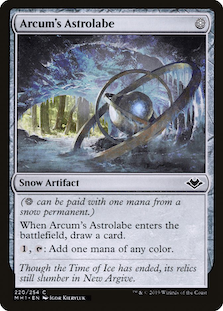 Nonblack midrange decks, without Thoughtseize and Inquisition of Kozilek, have always lacked effective turn-one plays. Using mana dorks exposes them in the removal-spell mirror; using filtering cantrips like Serum Visions still requires good guessing about an opponent's gameplan. Neither play disrupts opponents, which is what midrange decks need to do early in the game; as such, Temur for instance has always been dependent on opponents laying a one-drop they could Bolt. Arcum's Astrolabe flips the script as an extremely appealing turn-one play—it all but guarantees perfect mana for the rest of the game! It also jump-starts Ice-Fang Coatl, the next card present in all the above decks.
Nonblack midrange decks, without Thoughtseize and Inquisition of Kozilek, have always lacked effective turn-one plays. Using mana dorks exposes them in the removal-spell mirror; using filtering cantrips like Serum Visions still requires good guessing about an opponent's gameplan. Neither play disrupts opponents, which is what midrange decks need to do early in the game; as such, Temur for instance has always been dependent on opponents laying a one-drop they could Bolt. Arcum's Astrolabe flips the script as an extremely appealing turn-one play—it all but guarantees perfect mana for the rest of the game! It also jump-starts Ice-Fang Coatl, the next card present in all the above decks.
Ice-Fang Coatl bridges the gap into the mid-game, fixing midrange's turns 2-5. Reactive decks can struggle if they run out of removal for their opponent's creatures before their game-winners come online, but Coatl acts as a removal spell while digging them into more gas. It also trades with literally anything, giving a wedge like Temur that could never deal with huge creatures in the past a way to trade up.
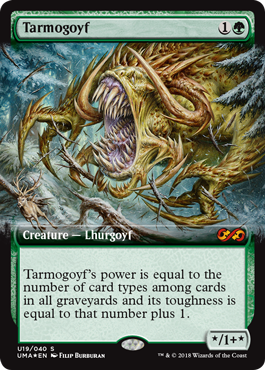 In the late-game, Uro has us covered. The Titan is a card-advantage engine while also being the most imposing body on the battlefield, making it perfect as a win-con—Uro is even useful along the way, drawing and developing the manabase from the hand.
In the late-game, Uro has us covered. The Titan is a card-advantage engine while also being the most imposing body on the battlefield, making it perfect as a win-con—Uro is even useful along the way, drawing and developing the manabase from the hand.
Unlike Once Upon a Time, which inhabits just two of them, this three-card core is present in every deck covered today (barring the last one), and I think it sets the standard for non-Jund midrange decks going forward. Jund itself is managing to keep up with Kroxa for the time being, but as I see things, Astro-Ice-Uro is where reactive attacking decks want to be in 2020. As for whether to Goyf, the question depends on how much attacking vs. countering players feel like doing—and it seems like any amount of either can be viable!



